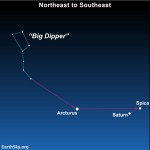liquid
"Everyone is a moon, and has a dark side which he never shows to anybody." -Mark Twain
Back before the telescope was invented, Saturn was known as the Old Man of the Skies. The slowest-moving of the naked-eye planets, it's the only one that would reliably be in nearly the same location, year after year. You can find it all summer, after sunset, by following the "arc" of the handle of the big dipper all the way until you run into the brightest northern-hemisphere star, Arcturus, and then speeding on to the very bright Spica. Saturn is right next door.
Image credit: EarthSky.org.
But…
Simple, but surprisingly charming - and somewhat reminiscent of an ant colony or other biological collective:
Fluid Sculpture (click for larger video) from Charlie Bucket on Vimeo.
Do restaurants and fishmongers frequently mislabel their fish so you think you are eating delicious thermal vent tube worm when you are really just eating pollock?
Why do shore birds run in fright from small lapping waves?
How does Kevin Z manage to trick us into reading his "writing?"
Learn more about these and other fishy tales from our credentialed but unemployable brethren over at Deep Sea News hosting Carnival of the Blue 18.
People love to speculate that Mars was once a great place for life to form, and claim that there is plenty of evidence that there used to be oceans and rivers there. But this isn't true. People used to claim there were big Canal-like features on Mars, and used this as evidence that Mars was very wet.
It was later realized that these weren't canals, but rather geological features caused by impact craters from astroids. But more recently, people have been claiming that images like the one above are examples of dried-up riverbeds.
But this turns out not to be the case. When we take a closer…

